Stories
29 Jun 2018
Confronting Structural Violence Through Street Art (Part 2)
Georgia: Country-Specific Street Art
Street Art as a Response to Violence by the Clergy
The below painting appeared in multiple places in the central streets of Tbilisi. It was part of the protest wave against violence organized by some clerics of the Georgian Orthodox Church. On May 17, 2013, priests led a mob of thousands against a small-scale demonstration that in turn was organized against homophobia. The mob chased and beat the peaceful rally participants in the narrow streets and in public transport. During these developments cameras captured an image of a priest holding a taburetka (the Russian word for “stool” in turn borrowed from French and still in common use in the Caucasus) and attacking with it the bus and people around it. As a result, the taburetka became a symbol of the church-motivated violence against human rights activists.

“Condemn Taburetka”. Artist: Unknown. Location: Rustaveli Avenue, Tbilisi, Georgia. Photo Credits: Maia Shalashvili. Date of the Photo: February 9, 2014.
Following the developments of May 17, 2013, another stenciled message appeared in the underground passage on Rustaveli Street in Tbilisi. The passage is in front of the Kashueti Church and Tbilisi Gymnasium N1. Its location, accessibility by thousands of people on a daily basis makes it popular among street artists. For the same reasons, the street art depicted on the walls of this passage is subject to stricter judgment and “censorship” by those who disagree with its form of expression or messages.
The words in the below stencil are an allusion to a phrase from the Gospel of John 8:1-11 in the Bible, where Jesus stops the mob from attacking the woman “caught in adultery”. In the story, the mob wants to stone her to death, and Jesus tells them, “Whichever one of you has committed no sin may throw the first stone at her”. Hearing this, the mob retreats. The message of this work reminds of the double standards of the Georgian Orthodox Church. Soon the message was painted over.

“Whichever one of you has committed no sin may throw the Taburetka first”. Artist: Unknown. Location: Rustaveli Avenue, Tbilisi, Georgia. Photo Credits: Maia Shalashvili. Date of the Photo: June 2, 2014.
Another message containing a hint was painted nearby – two hearts, a tiny one and a bigger one with respective writings underneath “The Heart of the Priest” and “The Heart of Jesus”. Similar to the previous one, it was also painted over.
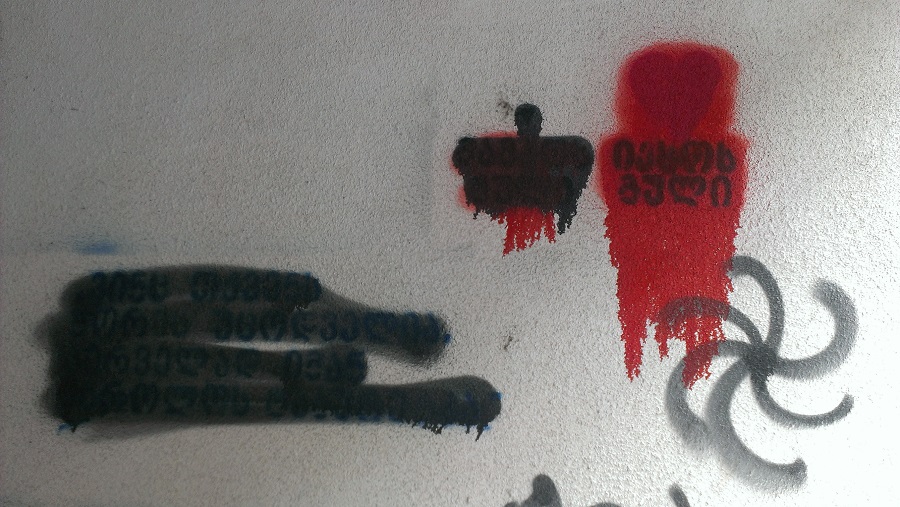
“The Heart of the Priest” and “The Heart of Jesus”. Artist: Unknown. Location: Rustaveli Avenue, Tbilisi, Georgia. Photo Credits: Maia Shalashvili. Date of the Photo: June 2, 2014.
The related piece below presents an “interpretation” of the famous human evolution chart, showing human progress from ape to homo sapiens, and regress from homo sapiens to a priest and a taburetka.
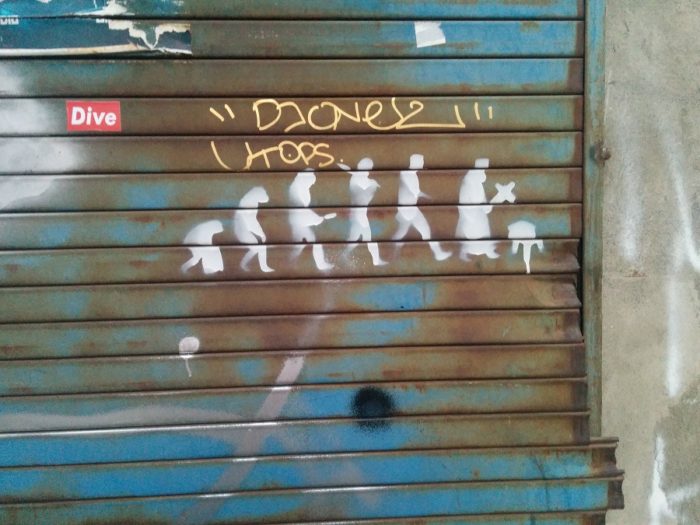
“Taburetka Evolution”. Artist: Unknown. Location: Tbilisi, Georgia. Photo Credits: Maia Shalashvili. Date of the Photo: June 8, 2016.
This next piece depicts a box with the writing “donation”, along with the symbols of cars – Audi, Mercedes, and BMW – to hint at the lavish lifestyle of high-level clerics. Receiving expensive cars as gifts and their usage is common among them. With this painting, the author reminds the society how far the clerics are from the values upheld by Christianity such as modesty, humility, and restraint.
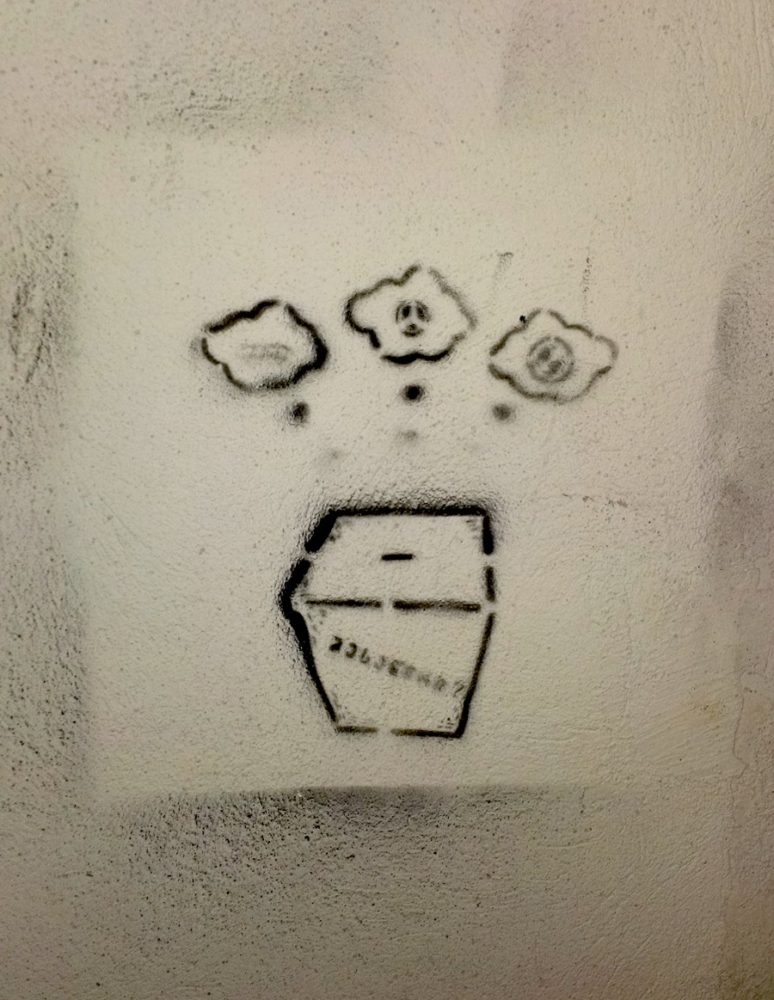
“Donation”. Artist: Unknown. Location: Tbilisi, Georgia. Photo Credits: Maia Shalashvili. Date of the Photo: January 26, 2014.
The figure of a cleric with the dollar sign on the walking stick sends a similar message. Made in front of the Rustaveli Metro Station in Tbilisi, this piece sarcastically showcases the wealth of the clerics and their luxurious lifestyle, inconsistent with what they preach.

A priest with a dollar sign above the walking stick and a “VIP-77” sign. Artist: Unknown. Location: near Rustaveli Metro Station, Tbilisi, Georgia. Photo Credits: Maia Shalashvili. Date of the Photo: February 16, 2014.
A similar figure was photographed only two weeks after the first one. This time, the image had been “edited”.

The partially erased image of the corrupt priest. Artist: Unknown. Location: Tbilisi, Georgia. Photo Credits: Maia Shalashvili. Date of the Photo: March 3, 2014.
For the Decriminalization of the Consumption of Light Drugs
A message under a cannabis leaf was part of a campaign devoted to the decriminalization of the usage of light drugs such as marijuana. At the time of the photograph in February 2014, the Criminal Code of Georgia foresaw imprisonment for their consumption. Since then, a long-term struggle and advocacy campaigns resulted to number of changes in the legislation. In December 2017, the Government of Georgia approved changes of legislation, which considered the abolishment of imprisonment for the production, purchase, storage, and consumption of small amounts of marijuana. Respective changes were made in the Criminal Code, the Administrative Violations Code, and other relevant laws. In November 2017, the Constitutional Court abolished criminal responsibility for the repeated consumption of marijuana.
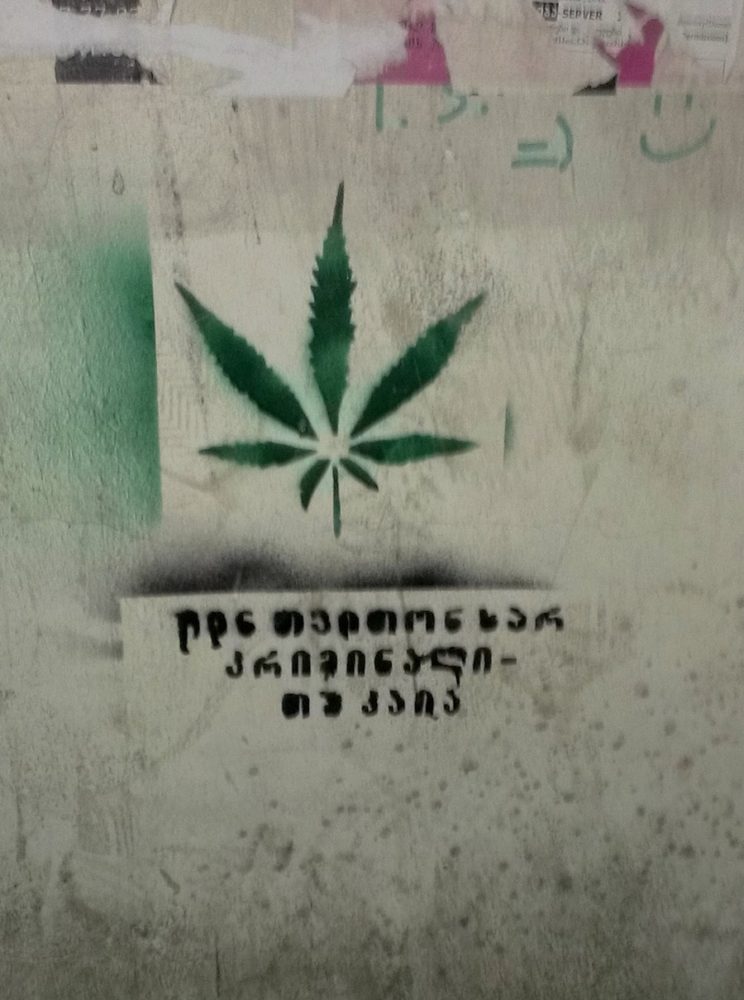
“It’s you who is a criminal”. Artist: Unknown. Location: Tbilisi, Georgia. Photo Credits: Maia Shalashvili. Date of the Photo: February 9, 2012.
In Favor of Labor Rights and Against Poor Working Conditions
The below artwork was photographed in January 2014. Back then, news about the harsh working condition of mine workers became very visible in the media. Public concerns grew into a protest campaign, including a small-scale rally in front of the Parliament building and a few graffiti paintings in the street.
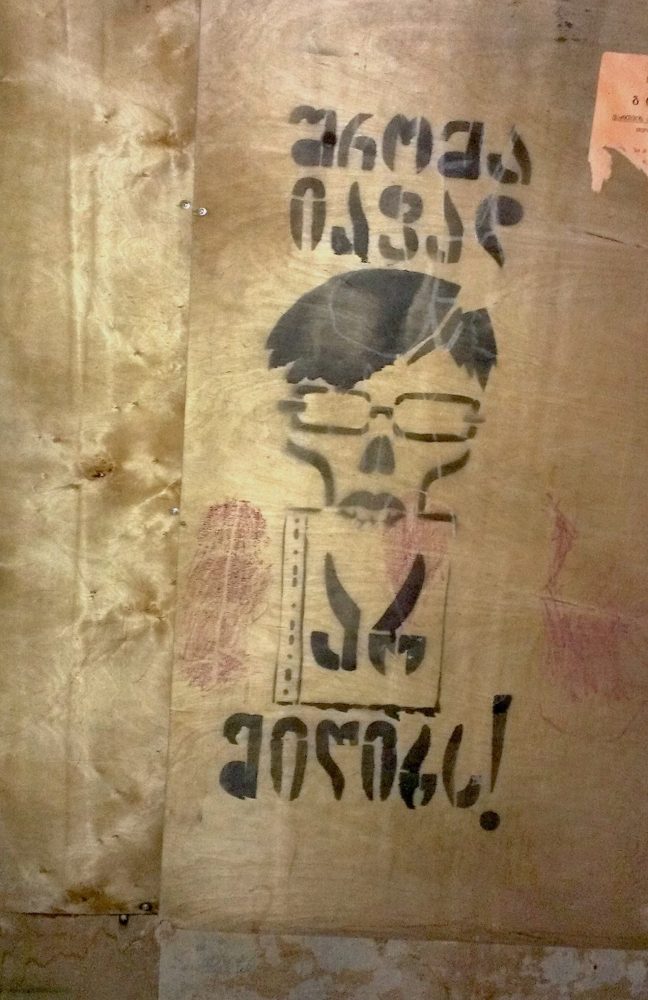
“Low wages are unfair for me”. Artist: Unknown. Location: Tbilisi, Georgia. Photo Credits: Maia Shalashvili. Date of the Photo: January 24, 2014.
The below painting appeared in Tbilisi around the same time, exposing the inhuman working conditions of the working class.
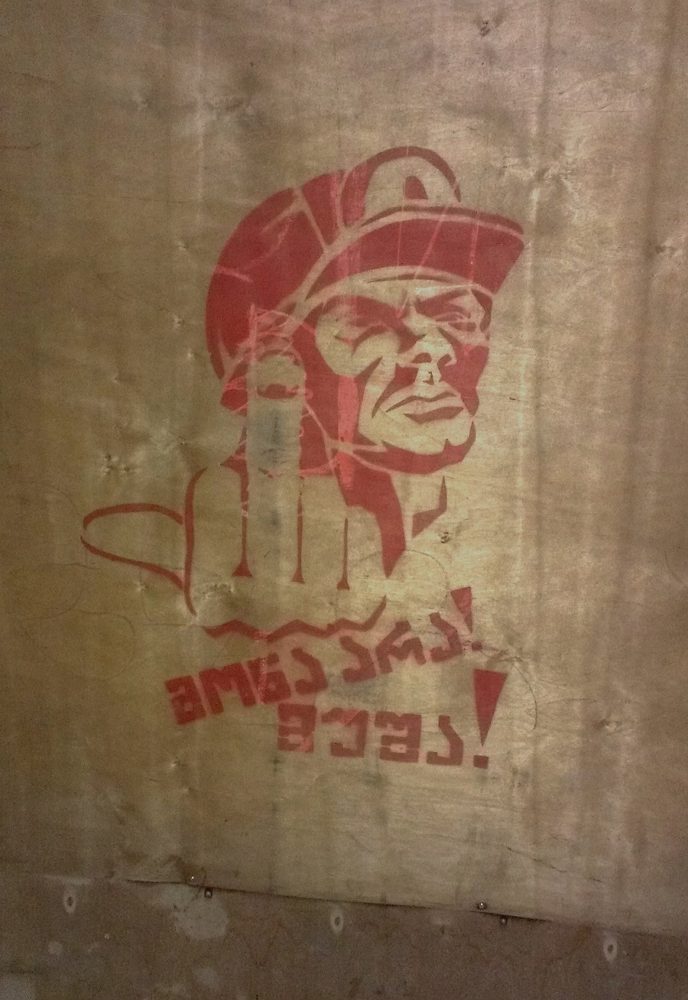
“Not a slave! A worker!”. Artist: Unknown. Location: Tbilisi, Georgia. Photo Credits: Maia Shalashvili. Date of the Photo: January 24, 2014.
The stenciled phrase “The City of Corpses” appeared in the underground passage in front of Building 1 of the Tbilisi State University on February 14, 2017. The movement Auditorium 115 placed it there immediately after the news of the death of a construction worker spread. Another phrase was added later – “1209. Rebel”. 1,209 stands as the number of the people who have died at construction works in Georgia in 2010-2017. Within a few months, the stencils were painted over.
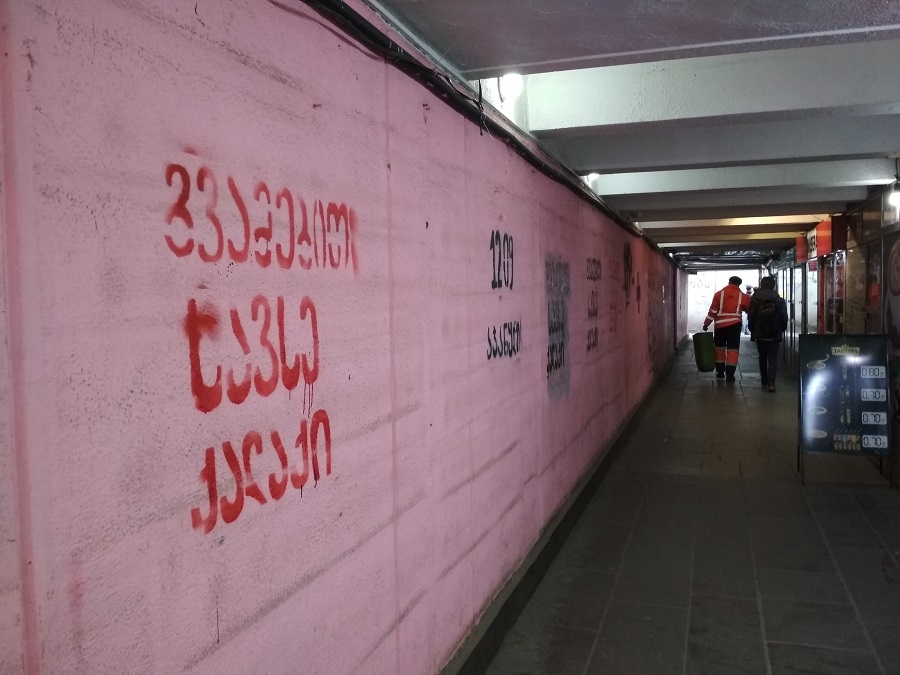
“The city of corpses” painted over. Artist: Auditorium 115. Location: Underground passage in front of Building 1 of the Tbilisi State University, Tbilisi. Date of the Photo: May 18, 2018. Photo Credits: Maia Shalashvili.
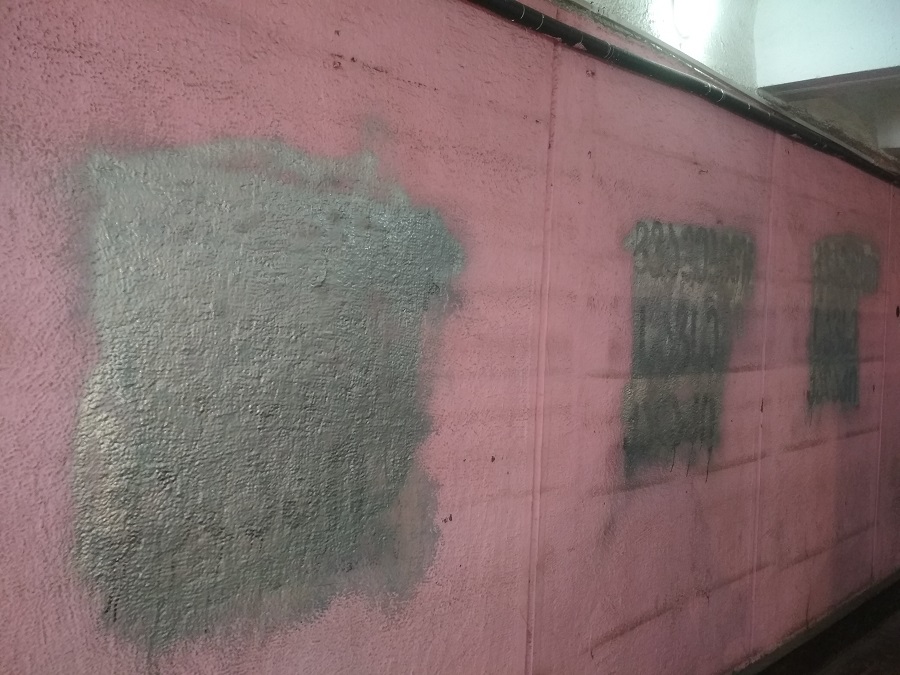
“The city of corpses” painted over. Artist: Auditorium 115. Location: Underground passage in front of Building 1 of the Tbilisi State University, Tbilisi. Date of the Photo: May 18, 2018. Photo Credits: Maia Shalashvili.

“1209 Rebel”. Artist: Auditorium 115. Location: Underground passage in front of Building 1 of the Tbilisi State University, Tbilisi, Georgia. Photo Credits: Maia Shalashvili. Date of the Photo: February 16, 2018.
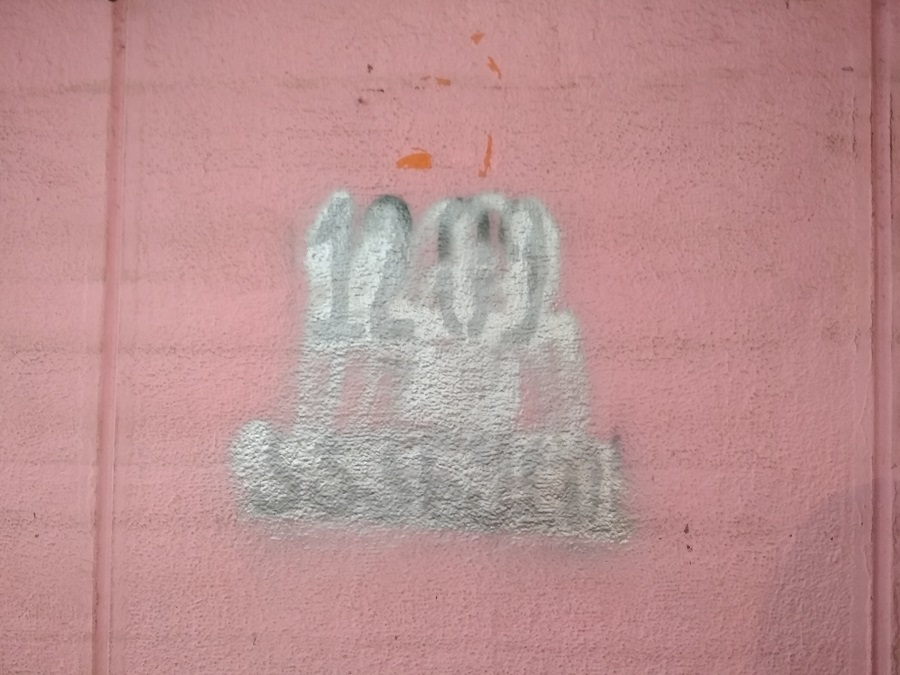
“1209 Rebel” painted over. Artist: Auditorium 115. Location: Underground passage in front of Building 1 of the Tbilisi State University, Tbilisi. Date of the Photo: May 18, 2018. Photo Credits: Maia Shalashvili.
The phrase “Value human labor” is written in several places in the central streets of Tbilisi. Once again, the author reminds about the need for decent wages for employees.
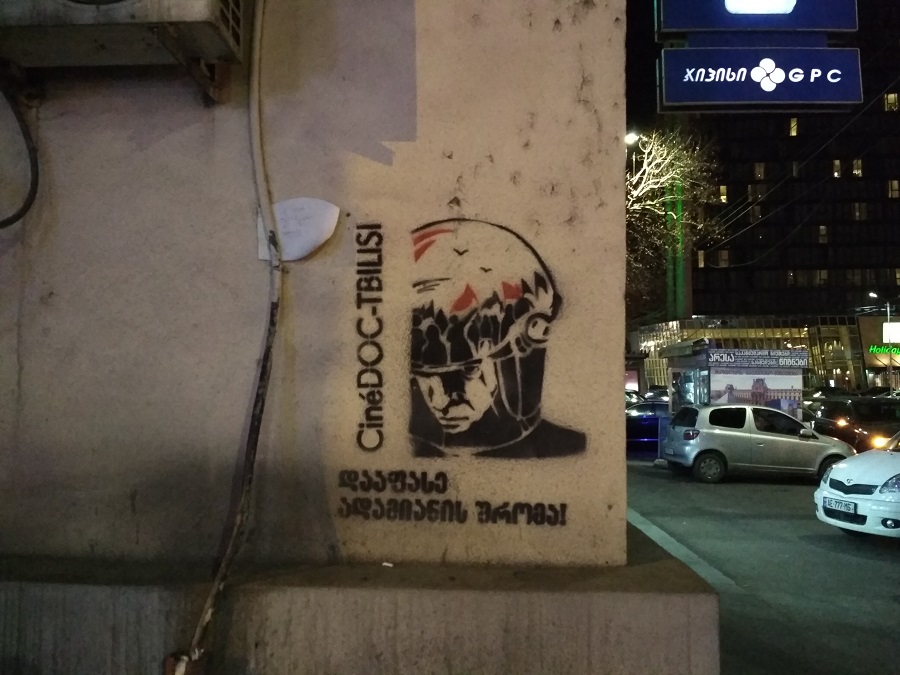
“Value human labor”. Artist: Unknown. Location: Underground passage in front of Building 1 of the Tbilisi State University, Tbilisi, Georgia. Photo Credits: Maia Shalashvili. Date of the Photo: February 16, 2018.
For the Inclusion of People with Disabilities
The below artwork belongs to the artist under the pseudonym Gagosh who placed it at the entrance of the subway station Medical University. The painting displays one of the challenges of public transport in Tbilisi: none of the metro stations are accessible for people with disabilities.
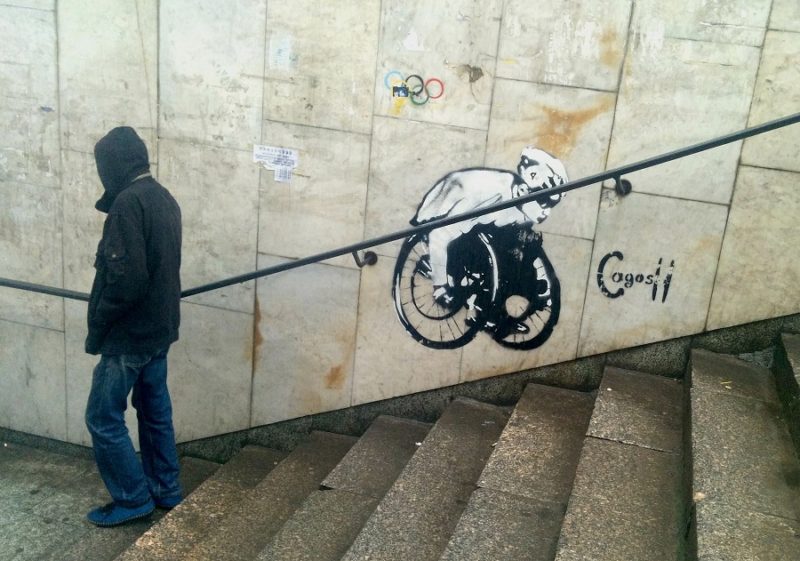
A person in a wheelchair wearing a helmet is going up/down the stairs. Artist: Gagosh. Location: Tbilisi, Georgia. Photo Credits: Maia Shalashvili. Date of the Photo: June 10, 2016.
Small paintings and writings on the walls along Rustaveli Street in Tbilisi expose the exclusion and invisibility of people with disabilities. “Do you really know me?” asks a person in the wheelchair. It hints to the low awareness about the issues and problems of people with disabilities. The photograph was taken on March 3, 2014 and is still there in 2018.
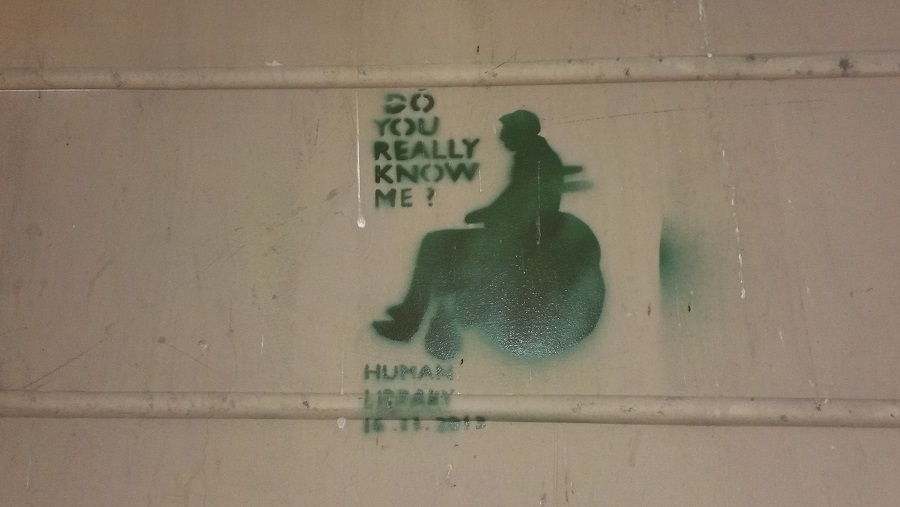
“Do you really know me?”. Artist: Unknown. Location: Rustaveli Avenue, Tbilisi, Georgia. Photo Credits: Maia Shalashvili. Date of the Photo: March 3, 2014.
The Struggle for Healthy Public Spaces – the Case of the Vake Park
The graffiti “Beware! A wicked investor is in the yard!” appeared in winter 2014 on the fence located in the Vake Park in Tbilisi. It was part of the widespread protest to protect the park and the largest green space in Tbilisi from the construction of a 7-storey hotel and its facilities there. The movement Guerilla Gardening Tbilisi organized a months-long camp and multiple events there. As a result of the long-term advocacy campaign and court hearings, Guerilla Gardening Tbilisi won the case in the First Instance Court, and the permission for the hotel construction was annulled. In Spring 2018, a new decision of the Appeal Court was announced which allowed the investors to continue construction in that place. The decision can be appealed to in the Supreme Court.
The below paintings appeared during this campaign to emphasize multiple environmental problems in Tbilisi, including the dominating business interests with investors ignoring the public demand on conserving green spaces, the high level of pollution in the city, making the conservation of green spaces even more crucial, the shrinking spaces that are safe and healthy for children to play.
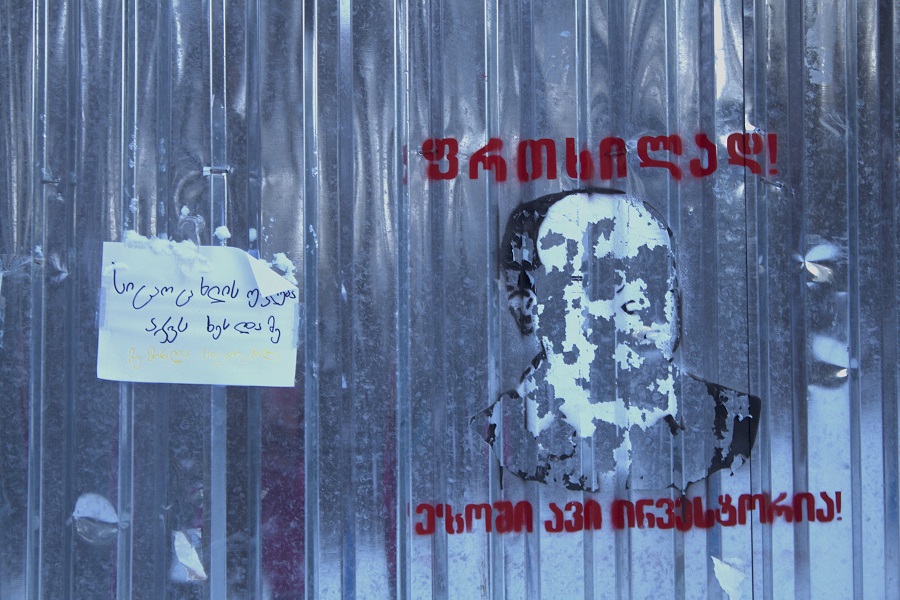
“Beware! A wicked investor is in the yard!”. Artist: Unknown. Location: Vake Park, Tbilisi, Georgia. Photo Credits: Maia Shalashvili. Date of the Photo: February 2, 2014.
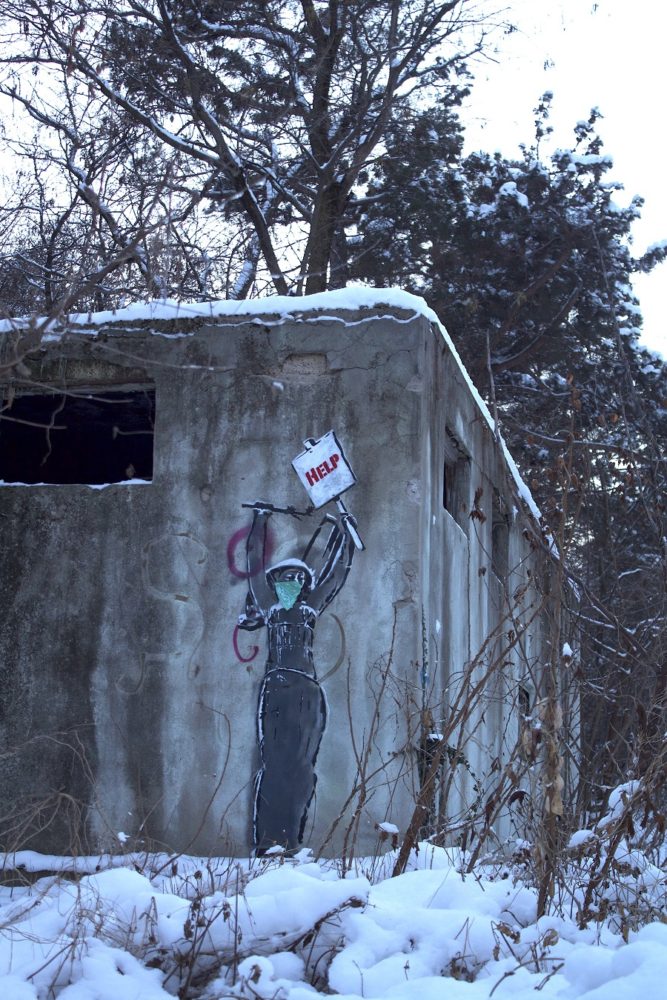
“Help” Artist: Unknown. Location: Vake Park, Tbilisi, Georgia. Photo Credits: Maia Shalashvili. Date of the Photo: February 2, 2014.
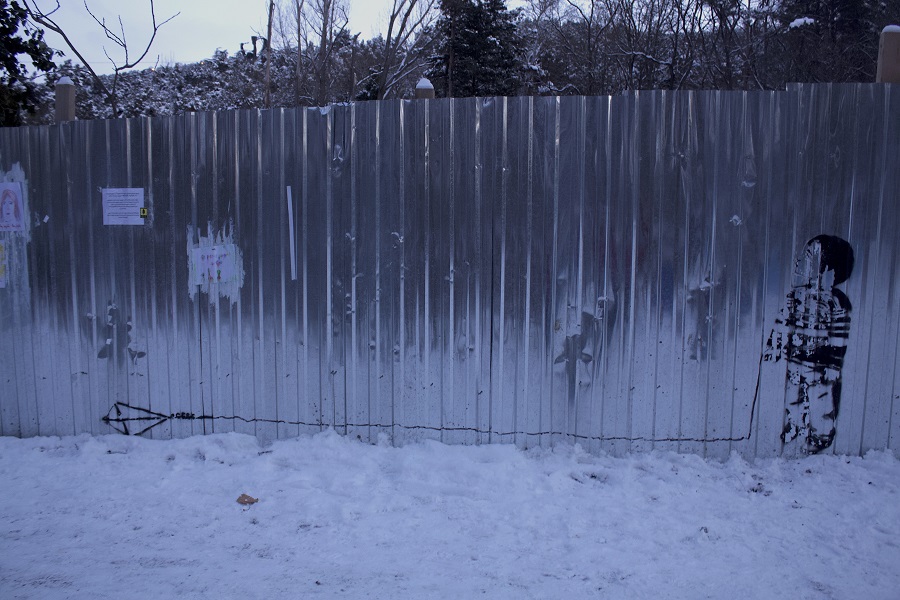
A child playing with a kite. Artist: Unknown. Location: Vake Park, Tbilisi, Georgia. Photo Credits: Maia Shalashvili. Date of the Photo: February 2, 2014.
Country-Specific Street Art in Armenia
Against Bullying and Violence in the Army
Every year, several soldiers commit suicide in the Armenian army. According to the statistics brought out by the non-governmental organization Peace Dialogue, for the period of 2010-2015, the total number was 48 (Khachatryan 2017). While the government prefers to keep the circumstances of these cases in secret, the public tries to get more information about the problem. People want to understand the reasons that drive young men to this fatal decision. The below painting was made in Yerevan to visualize the issue and remind the society about it. After some time, it was painted over.
Starting from January 2017, a new tax was introduced in Armenia. Every employee is obliged to contribute 1,000 Armenian Drams (about USD2) per month to a special fund. This fund covers the pensions and other payouts of the soldiers that have been wounded, deceased, or disabled in combat. The funds go to their families if the soldier died. A considerable part of the public negatively reacted to the decision, considering it militarization of the society or unjustified deductions from their low income.
The stenciled phrase “My son died, I paid my bank loan” is supposed to be the voice of the parent who has lost a son and has used the “compensation” funds to cover a bank loan, the latter being another component of the social hardship of many families.
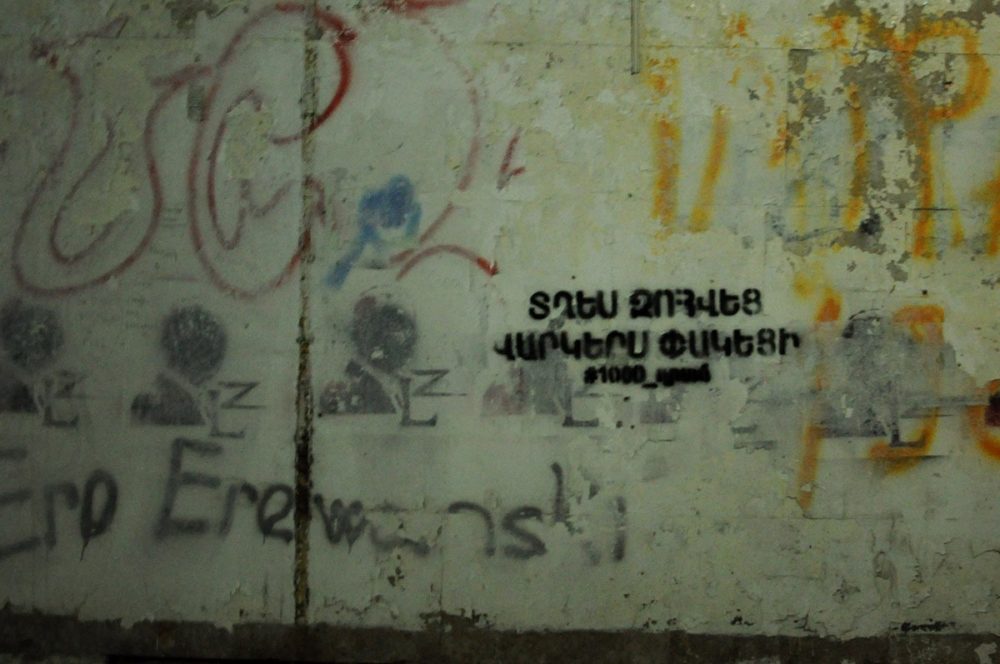
“My son died, I paid my bank loan. #1000drams”. Artist: Unknown. Location: Yerevan, Armenia. Date of the Photo: November 2016. Photo Credits: Ananun’s (meaning “anonymous”) Facebook page.
Street Art Expressing Resistance
Vardges Gaspari is an Armenian political activist. He is famous for his nonviolent resistance against the government. He uses “sit-down” or “lay-down” approaches to express his dissatisfaction with the government and its policies.
The below graffiti was made on a wall in Gyumri, Armenia. It shows Vardges Gaspari standing in a faceless crowd. He is the only person facing the audience and holding a placard with the words “Filth, murderer, scoundrel”.

Vardges Gaspari holding the sign “Filth, murderer, scoundrel”. Artist: Medialab. Location: Gyumri, Armenia. Date of the Photo: February 4, 2018. Photo Credits: Marianna Grigoryan’s Facebook page.
The following stenciled phrases also serve as reminders of the double standards and cases of injustice in the country.
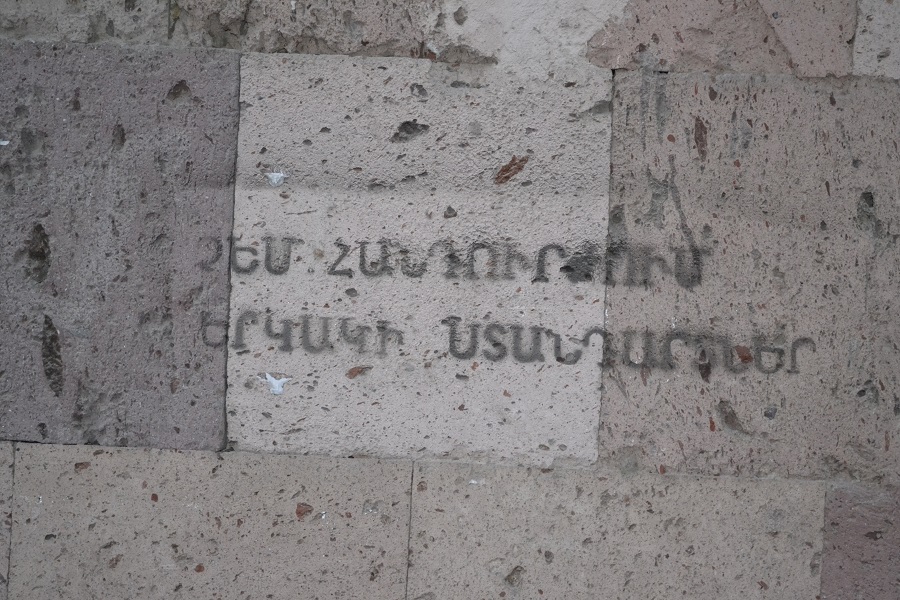
“I do not tolerate double standards”. Artist: Unknown. Location: Arami Street, Yerevan, Armenia. Photo Credits: Aren Melikyan. Date of the Photo: January 13, 2018.
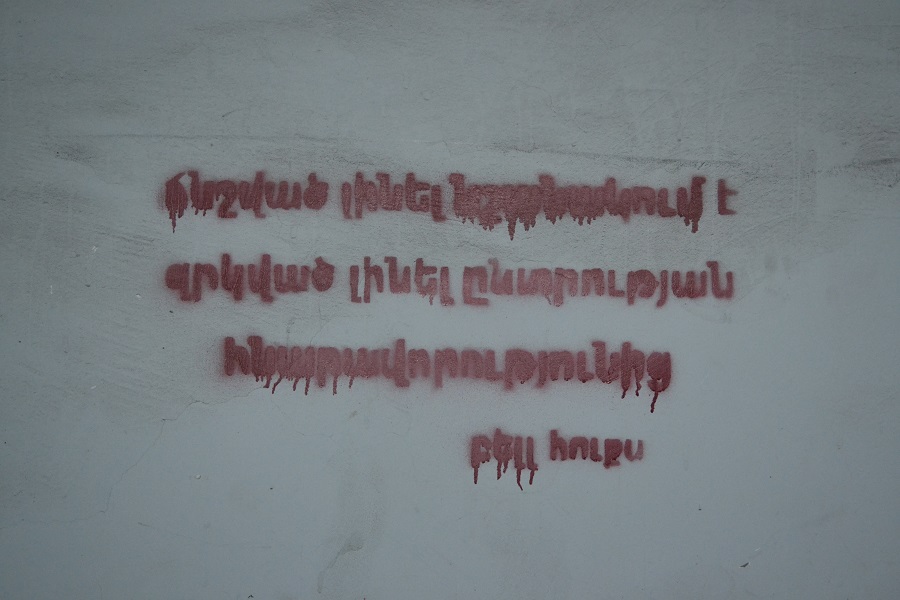
“Being downtrodden means being deprived of choice. bell hooks”. Artist: Unkown. Location: Spendiaryan Street, Yerevan, Armenia. Photo Credits: Aren Melikyan. Date of the Photo: January 18, 2018.
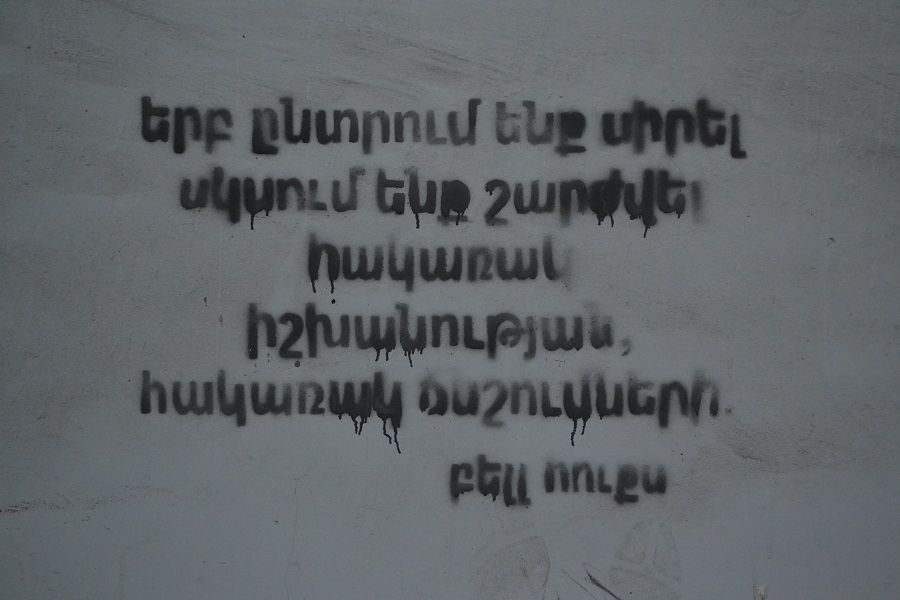
“When we choose to love, we start acting against power, against oppression. bell hooks”. Artist: Unknown. Location: Spendiaryan Street, Yerevan, Armenia. Photo Credits: Aren Melikyan. Date of the Photo: January 18, 2018.
Bibliography
Khachatryan, Edgar. 2017. “Murders, Suicides, and Fatal Accidents Plague the Armenian Military.” OC Media. February 24. Accessed March 8, 2018. http://oc-media.org/murders-suicides-and-fatal-accidents-plague-the-armenian-military/.
* This story has been produced with support from the US Embassies in the South Caucasus. The opinions expressed in the publication reflect the point of the view of the authors. They do not purport to reflect the opinions or views of the US Embassies.
** Read Part 1 of this Story here.
Leave a Comment